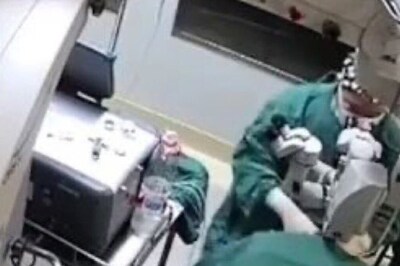
views
Bangalore: The conjoined twins of a Nigerian couple were successfully separated today after a 11-hour long surgery at a private hospital here, ending a prolonged wait and bringing unbounded joy to the parents.
Eight-month-old 'Peace' and 'Patience' "are stable as of now and are in the ICU. We have to monitor their progress," Dr Ashley D'Cruz, General Pediatric surgeon at Narayana Hrydayalaya told PTI.
The twins born to Emmanuel and Comfort Adgube weighed 10 kgs and shared common liver and intestine when they were brought to Narayana Hrydayalaya.
The surgery, which began at around 6.30 am, concluded at 5.30 pm and involved a team of 24 personnel, including 14 doctors, D'Cruz said.
"It was a very complex surgery as both twins shared two thirds of the intestine." The surgery which took days of meticulous planning and several rounds of discussions, involved separating their bowels and allocating each a part of the bowel, he said.
D'Cruz said their duodenum was fused and had to be separated and reconstructed. The last part of the surgery involved separation of the liver.
The toughest moment was separating the bile duct and allocating part of it to each, he said, adding "we are happy with the success, it was professionally a very challenging task."
The mortality rate worldwide for such conjoined twins is 30 per cent, he said.
The operation comes two years after the hospital successfully treated two-year-old Lakshmi, an eight-limbed infant, said Ashley.
Conjoined twins arise from a single embryo. They are identical twins fused due to failure of separation early in foetal life. They are always of the same sex and girls outnumber boys.
There are many types of conjoined twins and they are named according to the site of joining, suffixed by the word pagus, meaning fixed. If fused at the head, they are called cephalopagus (cephalos means head and pagus means fixed), he said.
The most famous conjoined twins were Chang and Eng. Joined at the sternum, they were born in a boat in Siam. They lived till the age of 68, married two sisters and had 22 children between them.
Fifty per cent of conjoined twins die in the womb and another 25 per cent die soon after birth. Successful separation has only been possible in recent years.
The management of conjoined twins is either non-operative, when they cannot be separated due to important shared structures or emergency separation when due to illness or death of one of them they have to be separated to save the other.
In most cases, they are separated electively as a planned operation, usually three months after birth.


















Comments
0 comment